Can You Have Camera Photo Hobby Air Force
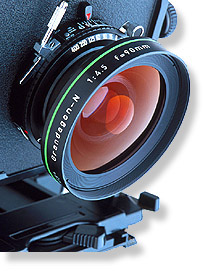 Lens and mounting of a big-format photographic camera | |
| Other names | Science or art of creating durable images |
|---|---|
| Types | Recording low-cal or other electromagnetic radiation |
| Inventor | Louis Daguerre (1839) Henry Flim-flam Talbot (1839) |
| Related | Stereoscopic, Full-spectrum, Light field, Electrophotography, Photograms, Scanner |
Photography is the art, awarding, and practice of creating durable images by recording light, either electronically by ways of an image sensor, or chemically by means of a calorie-free-sensitive material such equally photographic film. It is employed in many fields of science, manufacturing (e.grand., photolithography), and business organization, every bit well equally its more than direct uses for fine art, movie and video production, recreational purposes, hobby, and mass advice.[1]
Typically, a lens is used to focus the light reflected or emitted from objects into a real image on the calorie-free-sensitive surface inside a camera during a timed exposure. With an electronic image sensor, this produces an electrical charge at each pixel, which is electronically candy and stored in a digital image file for subsequent brandish or processing. The result with photographic emulsion is an invisible latent image, which is later chemically "developed" into a visible image, either negative or positive, depending on the purpose of the photographic material and the method of processing. A negative image on film is traditionally used to photographically create a positive image on a newspaper base, known equally a print, either by using an enlarger or past contact printing.
Etymology [edit]
The word "photography" was created from the Greek roots φωτός (phōtós), genitive of φῶς (phōs), "low-cal"[ii] and γραφή (graphé) "representation by means of lines" or "drawing",[iii] together meaning "drawing with light".[four]
Several people may take coined the same new term from these roots independently. Hercules Florence, a French painter and inventor living in Campinas, Brazil, used the French form of the word, photographie, in individual notes which a Brazilian historian believes were written in 1834.[5] This claim is widely reported only is not nevertheless largely recognized internationally. The first use of the word past the Franco-Brazilian inventor became widely known later on the enquiry of Boris Kossoy in 1980.[vi]
The German newspaper Vossische Zeitung of 25 Feb 1839 contained an article entitled Photographie, discussing several priority claims – especially Henry Fox Talbot's – regarding Daguerre's claim of invention.[7] The article is the primeval known occurrence of the give-and-take in public print.[8] It was signed "J.One thousand.", believed to have been Berlin astronomer Johann von Maedler.[9] The astronomer Sir John Herschel is also credited with coining the word, contained of Talbot, in 1839.[ten]
The inventors Nicéphore Niépce, Henry Play a trick on Talbot and Louis Daguerre seem not to accept known or used the word "photography", but referred to their processes equally "Heliography" (Niépce), "Photogenic Drawing"/"Talbotype"/"Calotype" (Talbot) and "Daguerreotype" (Daguerre).[9]
History [edit]
Precursor technologies [edit]
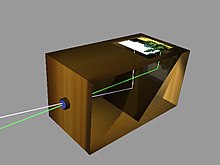
A photographic camera obscura used for drawing
Photography is the issue of combining several technical discoveries, relating to seeing an paradigm and capturing the image. The discovery of the camera obscura ("dark chamber" in Latin) that provides an image of a scene dates dorsum to ancient Mainland china. Greek mathematicians Aristotle and Euclid independently described a camera obscura in the fifth and 4th centuries BCE.[11] [12] In the 6th century CE, Byzantine mathematician Anthemius of Tralles used a blazon of camera obscura in his experiments.[13]
The Arab physicist Ibn al-Haytham (Alhazen) (965–1040) too invented a camera obscura as well every bit the first true pinhole camera.[12] [fourteen] [fifteen] The invention of the camera has been traced dorsum to the piece of work of Ibn al-Haytham.[sixteen] While the furnishings of a single light passing through a pinhole had been described before,[16] Ibn al-Haytham gave the first correct analysis of the photographic camera obscura,[17] including the first geometrical and quantitative descriptions of the phenomenon,[18] and was the offset to apply a screen in a nighttime room so that an image from one side of a pigsty in the surface could be projected onto a screen on the other side.[19] He also showtime understood the human relationship between the focal point and the pinhole,[xx] and performed early experiments with afterimages, laying the foundations for the invention of photography in the 19th century.[15]
Leonardo da Vinci mentions natural camerae obscurae that are formed by dark caves on the edge of a sunlit valley. A hole in the cave wall volition act as a pinhole photographic camera and projection a laterally reversed, upside down image on a piece of newspaper. Renaissance painters used the camera obscura which, in fact, gives the optical rendering in color that dominates Western Art. It is a box with a minor hole in one side, which allows specific light rays to enter, projecting an inverted image onto a viewing screen or paper.
The birth of photography was then concerned with inventing means to capture and go on the image produced by the camera obscura. Albertus Magnus (1193–1280) discovered silver nitrate,[21] and Georg Fabricius (1516–1571) discovered silver chloride,[22] and the techniques described in Ibn al-Haytham'southward Book of Optics are capable of producing primitive photographs using medieval materials.[23] [24]
Daniele Barbaro described a diaphragm in 1566.[25] Wilhelm Homberg described how calorie-free darkened some chemicals (photochemical effect) in 1694.[26] The fiction book Giphantie, published in 1760, by French author Tiphaigne de la Roche, described what can be interpreted equally photography.[25]
Effectually the year 1800, British inventor Thomas Wedgwood made the first known effort to capture the image in a photographic camera obscura by ways of a light-sensitive substance. He used paper or white leather treated with silver nitrate. Although he succeeded in capturing the shadows of objects placed on the surface in direct sunlight, and even made shadow copies of paintings on glass, information technology was reported in 1802 that "the images formed by means of a camera obscura accept been found as well faint to produce, in any moderate fourth dimension, an event upon the nitrate of silverish." The shadow images eventually darkened all over.[27]
Invention [edit]
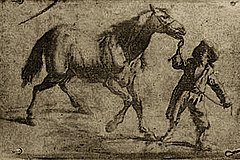
Earliest known surviving heliographic engraving, 1825, printed from a metal plate made past Nicéphore Niépce.[28] The plate was exposed under an ordinary engraving and copied it by photographic means. This was a footstep towards the first permanent photograph taken with a camera.

View of the Boulevard du Temple, a daguerreotype fabricated by Louis Daguerre in 1838, is by and large accepted as the earliest photo to include people. It is a view of a busy street, but because the exposure lasted for several minutes the moving traffic left no trace. Only the two men about the bottom left corner, 1 of them obviously having his boots polished by the other, remained in i place long enough to be visible.
The get-go permanent photoetching was an image produced in 1822 by the French inventor Nicéphore Niépce, but it was destroyed in a later attempt to make prints from information technology.[28] Niépce was successful again in 1825. In 1826 or 1827, he made the View from the Window at Le Gras, the earliest surviving photograph from nature (i.e., of the image of a real-world scene, every bit formed in a photographic camera obscura by a lens).[29]

Because Niépce'due south camera photographs required an extremely long exposure (at to the lowest degree eight hours and probably several days), he sought to greatly improve his bitumen process or replace it with one that was more practical. In partnership with Louis Daguerre, he worked out post-exposure processing methods that produced visually superior results and replaced the bitumen with a more light-sensitive resin, but hours of exposure in the camera were still required. With an centre to eventual commercial exploitation, the partners opted for full secrecy.
Niépce died in 1833 and Daguerre then redirected the experiments toward the light-sensitive silvery halides, which Niépce had abased many years earlier because of his inability to brand the images he captured with them light-fast and permanent. Daguerre's efforts culminated in what would after be named the daguerreotype procedure. The essential elements—a silver-plated surface sensitized by iodine vapor, developed past mercury vapor, and "stock-still" with hot saturated salt water—were in place in 1837. The required exposure time was measured in minutes instead of hours. Daguerre took the earliest confirmed photograph of a person in 1838 while capturing a view of a Paris street: unlike the other pedestrian and horse-fatigued traffic on the busy boulevard, which appears deserted, 1 human having his boots polished stood sufficiently still throughout the several-minutes-long exposure to be visible. The beingness of Daguerre's process was publicly announced, without details, on 7 January 1839. The news created an international sensation. French republic soon agreed to pay Daguerre a alimony in exchange for the right to nowadays his invention to the world as the souvenir of France, which occurred when consummate working instructions were unveiled on xix August 1839. In that aforementioned year, American photographer Robert Cornelius is credited with taking the earliest surviving photographic self-portrait.
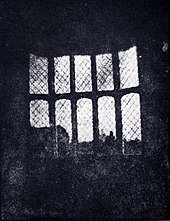
A latticed window in Lacock Abbey, England, photographed by William Play a trick on Talbot in 1835. Shown here in positive form, this may exist the oldest extant photographic negative made in a camera.
In Brazil, Hercules Florence had evidently started working out a silverish-salt-based newspaper process in 1832, subsequently naming it Photographie.
Meanwhile, a British inventor, William Play a joke on Talbot, had succeeded in making rough but reasonably lite-fast argent images on paper as early as 1834 just had kept his piece of work hole-and-corner. Subsequently reading well-nigh Daguerre'south invention in January 1839, Talbot published his hitherto secret method and gear up about improving on it. At get-go, similar other pre-daguerreotype processes, Talbot'due south paper-based photography typically required hours-long exposures in the camera, but in 1840 he created the calotype procedure, which used the chemical evolution of a latent image to greatly reduce the exposure needed and compete with the daguerreotype. In both its original and calotype forms, Talbot's process, unlike Daguerre'southward, created a translucent negative which could be used to impress multiple positive copies; this is the basis of near modern chemic photography upwardly to the nowadays solar day, as daguerreotypes could simply be replicated by rephotographing them with a camera.[xxx] Talbot'south famous tiny paper negative of the Oriel window in Lacock Abbey, one of a number of camera photographs he made in the summer of 1835, may be the oldest photographic camera negative in existence.[31] [32]
In France, Hippolyte Bayard invented his own process for producing directly positive newspaper prints and claimed to have invented photography before than Daguerre or Talbot.[33]
British chemist John Herschel made many contributions to the new field. He invented the cyanotype process, later familiar as the "blueprint". He was the first to apply the terms "photography", "negative" and "positive". He had discovered in 1819 that sodium thiosulphate was a solvent of silver halides, and in 1839 he informed Talbot (and, indirectly, Daguerre) that it could be used to "prepare" silver-halide-based photographs and make them completely light-fast. He made the first glass negative in late 1839.
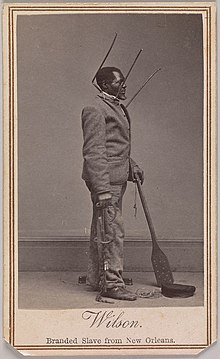
Wilson Chinn, a branded slave from Louisiana--per The New York Times, "one of the earliest and well-nigh dramatic examples of how the newborn medium of photography could modify the course of history."[34]

Advertising for Campbell's Photograph Gallery from The Macon City Directory, circa 1877.
In the March 1851 consequence of The Chemist, Frederick Scott Archer published his wet plate collodion process. It became the nearly widely used photographic medium until the gelatin dry out plate, introduced in the 1870s, somewhen replaced information technology. There are three subsets to the collodion process; the Ambrotype (a positive paradigm on drinking glass), the Ferrotype or Tintype (a positive image on metal) and the glass negative, which was used to brand positive prints on albumen or salted paper.
Many advances in photographic glass plates and printing were made during the rest of the 19th century. In 1891, Gabriel Lippmann introduced a procedure for making natural-color photographs based on the optical miracle of the interference of light waves. His scientifically elegant and important but ultimately impractical invention earned him the Nobel Prize in Physics in 1908.
Glass plates were the medium for most original photographic camera photography from the late 1850s until the general introduction of flexible plastic films during the 1890s. Although the convenience of the picture show profoundly popularized amateur photography, early films were somewhat more expensive and of markedly lower optical quality than their glass plate equivalents, and until the late 1910s they were not available in the large formats preferred by most professional photographers, and then the new medium did not immediately or completely replace the old. Because of the superior dimensional stability of glass, the use of plates for some scientific applications, such as astrophotography, connected into the 1990s, and in the niche field of light amplification by stimulated emission of radiation holography, it has persisted into the 21st century.
Picture [edit]

Undeveloped Arista black-and-white film, ISO 125/22°
Hurter and Driffield began pioneering work on the low-cal sensitivity of photographic emulsions in 1876. Their work enabled the outset quantitative measure of film speed to be devised.
The first flexible photographic whorl film was marketed by George Eastman, founder of Kodak in 1885, but this original "film" was actually a blanket on a newspaper base. As part of the processing, the paradigm-bearing layer was stripped from the paper and transferred to a hardened gelatin back up. The first transparent plastic whorl film followed in 1889. Information technology was fabricated from highly combustible nitrocellulose known equally nitrate moving picture.
Although cellulose acetate or "safety flick" had been introduced past Kodak in 1908,[35] at first it found only a few special applications every bit an alternative to the hazardous nitrate picture, which had the advantages of being considerably tougher, slightly more transparent, and cheaper. The changeover was not completed for X-ray films until 1933, and although prophylactic picture was always used for 16 mm and 8 mm home movies, nitrate picture show remained standard for theatrical 35 mm move pictures until it was finally discontinued in 1951.
Films remained the ascendant course of photography until the early 21st century when advances in digital photography drew consumers to digital formats.[36] Although modern photography is dominated by digital users, moving-picture show continues to be used by enthusiasts and professional person photographers. The distinctive "look" of film based photographs compared to digital images is likely due to a combination of factors, including: (i) differences in spectral and tonal sensitivity (S-shaped density-to-exposure (H&D curve) with film vs. linear response curve for digital CCD sensors)[37] (2) resolution and (iii) continuity of tone.[38]
Black-and-white [edit]

Originally, all photography was monochrome, or black-and-white. Even after color picture show was readily bachelor, black-and-white photography connected to dominate for decades, due to its lower toll, chemic stability, and its "classic" photographic expect. The tones and contrast between light and dark areas define black-and-white photography.[39] Monochromatic pictures are not necessarily composed of pure blacks, whites, and intermediate shades of gray but tin can involve shades of one particular hue depending on the procedure. The cyanotype process, for example, produces an image equanimous of blueish tones. The albumen print procedure, publicly revealed in 1847, produces brown tones.
Many photographers continue to produce some monochrome images, sometimes because of the established archival permanence of well-candy argent-halide-based materials. Some full-colour digital images are processed using a variety of techniques to create black-and-white results, and some manufacturers produce digital cameras that exclusively shoot monochrome. Monochrome printing or electronic display tin can exist used to salvage certain photographs taken in color which are unsatisfactory in their original class; sometimes when presented as black-and-white or single-color-toned images they are found to exist more constructive. Although color photography has long predominated, monochrome images are all the same produced, more often than not for artistic reasons. Most all digital cameras have an option to shoot in monochrome, and almost all epitome editing software tin can combine or selectively discard RGB color channels to produce a monochrome image from i shot in color.
Color [edit]
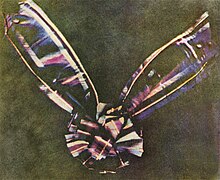
Color photography was explored first in the 1840s. Early on experiments in color required extremely long exposures (hours or days for photographic camera images) and could not "set" the photograph to forbid the color from quickly fading when exposed to white light.
The first permanent color photograph was taken in 1861 using the three-colour-separation principle first published past Scottish physicist James Clerk Maxwell in 1855.[40] [41] The foundation of virtually all applied color processes, Maxwell's idea was to take three dissever blackness-and-white photographs through blood-red, light-green and bluish filters.[40] [41] This provides the lensman with the three basic channels required to recreate a color image. Transparent prints of the images could exist projected through similar colour filters and superimposed on the projection screen, an condiment method of colour reproduction. A color print on paper could be produced by superimposing carbon prints of the three images made in their complementary colors, a subtractive method of color reproduction pioneered by Louis Ducos du Hauron in the late 1860s.
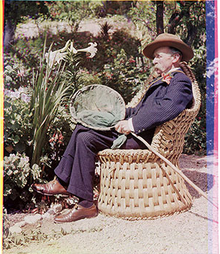
Color photography was possible long before Kodachrome, every bit this 1903 portrait past Sarah Angelina Acland demonstrates, but in its primeval years, the need for special equipment, long exposures, and complicated printing processes fabricated it extremely rare.
Russian lensman Sergei Mikhailovich Prokudin-Gorskii made extensive use of this color separation technique, employing a special camera which successively exposed the three colour-filtered images on dissimilar parts of an oblong plate. Because his exposures were not simultaneous, unsteady subjects exhibited color "fringes" or, if rapidly moving through the scene, appeared as brightly colored ghosts in the resulting projected or printed images.
Implementation of color photography was hindered past the limited sensitivity of early photographic materials, which were mostly sensitive to blue, only slightly sensitive to green, and about insensitive to carmine. The discovery of dye sensitization past photochemist Hermann Vogel in 1873 suddenly made it possible to add sensitivity to green, yellow and even red. Improved color sensitizers and ongoing improvements in the overall sensitivity of emulsions steadily reduced the once-prohibitive long exposure times required for color, bringing it ever closer to commercial viability.
Autochrome, the beginning commercially successful color process, was introduced past the Lumière brothers in 1907. Autochrome plates incorporated a mosaic color filter layer made of dyed grains of irish potato starch, which allowed the three color components to be recorded equally adjacent microscopic image fragments. Subsequently an Autochrome plate was reversal processed to produce a positive transparency, the starch grains served to illuminate each fragment with the correct color and the tiny colored points blended together in the eye, synthesizing the color of the subject past the additive method. Autochrome plates were one of several varieties of additive color screen plates and films marketed between the 1890s and the 1950s.
Kodachrome, the first modern "integral tripack" (or "monopack") colour moving-picture show, was introduced by Kodak in 1935. It captured the iii color components in a multi-layer emulsion. Ane layer was sensitized to tape the ruddy-dominated part of the spectrum, some other layer recorded only the green office and a third recorded but the blueish. Without special pic processing, the result would just be three superimposed black-and-white images, but complementary cyan, magenta, and yellow dye images were created in those layers by adding color couplers during a complex processing procedure.
Agfa'southward similarly structured Agfacolor Neu was introduced in 1936. Unlike Kodachrome, the color couplers in Agfacolor Neu were incorporated into the emulsion layers during industry, which greatly simplified the processing. Currently, available color films still employ a multi-layer emulsion and the same principles, almost closely resembling Agfa'south product.
Instant color motion picture, used in a special camera which yielded a unique finished colour impress only a infinitesimal or two afterward the exposure, was introduced by Polaroid in 1963.
Color photography may form images as positive transparencies, which tin exist used in a slide projector, or as color negatives intended for employ in creating positive color enlargements on specially coated paper. The latter is now the most common form of moving-picture show (non-digital) color photography owing to the introduction of automated photo printing equipment. After a transition period centered around 1995–2005, color film was relegated to a niche market place by inexpensive multi-megapixel digital cameras. Film continues to be the preference of some photographers because of its distinctive "wait".
Digital [edit]

Kodak DCS 100, based on a Nikon F3 trunk with Digital Storage Unit
In 1981, Sony unveiled the get-go consumer photographic camera to use a accuse-coupled device for imaging, eliminating the demand for film: the Sony Mavica. While the Mavica saved images to disk, the images were displayed on idiot box, and the camera was not fully digital.
The first digital camera to both record and salvage images in a digital format was the Fujix DS-1P created past Fujfilm in 1988.[42]
In 1991, Kodak unveiled the DCS 100, the outset commercially available digital single lens reflex photographic camera. Although its high price precluded uses other than photojournalism and professional photography, commercial digital photography was born.
Digital imaging uses an electronic image sensor to record the image as a gear up of electronic information rather than every bit chemic changes on film.[43] An important deviation between digital and chemical photography is that chemical photography resists photo manipulation considering it involves film and photographic newspaper, while digital imaging is a highly manipulative medium. This difference allows for a degree of paradigm mail-processing that is comparatively difficult in film-based photography and permits different communicative potentials and applications.

Photography on a smartphone
Digital photography dominates the 21st century. More than 99% of photographs taken around the globe are through digital cameras, increasingly through smartphones.
Techniques [edit]

Angles such equally vertical, horizontal, or as pictured here diagonal are considered important photographic techniques
A big diversity of photographic techniques and media are used in the process of capturing images for photography. These include the camera; dualphotography; full-spectrum, ultraviolet and infrared media; calorie-free field photography; and other imaging techniques.
Cameras [edit]
The camera is the image-forming device, and a photographic plate, photographic film or a silicon electronic epitome sensor is the capture medium. The respective recording medium can be the plate or moving-picture show itself, or a digital magnetic or electronic retentivity.[44]
Photographers control the camera and lens to "expose" the calorie-free recording material to the required amount of light to form a "latent image" (on plate or moving picture) or RAW file (in digital cameras) which, afterwards appropriate processing, is converted to a usable paradigm. Digital cameras employ an electronic image sensor based on light-sensitive electronics such as accuse-coupled device (CCD) or complementary metallic-oxide-semiconductor (CMOS) engineering. The resulting digital image is stored electronically, but can be reproduced on a paper.
The camera (or 'camera obscura') is a dark room or chamber from which, equally far equally possible, all lite is excluded except the light that forms the image. It was discovered and used in the 16th century past painters. The subject area existence photographed, however, must exist illuminated. Cameras can range from small to very large, a whole room that is kept dark while the object to exist photographed is in another room where it is properly illuminated. This was common for reproduction photography of flat copy when large film negatives were used (see Process camera).
As soon as photographic materials became "fast" (sensitive) enough for taking candid or cloak-and-dagger pictures, small "detective" cameras were made, some actually disguised as a book or purse or pocket watch (the Ticka camera) or even worn hidden behind an Ascot necktie with a necktie pin that was really the lens.
The movie camera is a type of photographic photographic camera which takes a rapid sequence of photographs on recording medium. In contrast to a still camera, which captures a single snapshot at a time, the movie photographic camera takes a serial of images, each chosen a "frame". This is achieved through an intermittent mechanism. The frames are later on played back in a motion-picture show projector at a specific speed, called the "frame charge per unit" (number of frames per second). While viewing, a person'due south eyes and brain merge the separate pictures to create the illusion of motility.[45]
Stereoscopic [edit]
Photographs, both monochrome and colour, can be captured and displayed through ii side-past-side images that emulate human stereoscopic vision. Stereoscopic photography was the beginning that captured figures in motion.[46] While known colloquially as "three-D" photography, the more accurate term is stereoscopy. Such cameras take long been realized by using picture and more recently in digital electronic methods (including cell phone cameras).
Dualphotography [edit]

An instance of a dualphoto using a smartphone based app
Dualphotography consists of photographing a scene from both sides of a photographic device at once (e.thou. camera for back-to-back dualphotography, or 2 networked cameras for portal-plane dualphotography). The dualphoto apparatus can be used to simultaneously capture both the field of study and the photographer, or both sides of a geographical identify at once, thus calculation a supplementary narrative layer to that of a unmarried prototype.[47]
Full-spectrum, ultraviolet and infrared [edit]

Ultraviolet and infrared films have been bachelor for many decades and employed in a variety of photographic avenues since the 1960s. New technological trends in digital photography have opened a new management in full spectrum photography, where careful filtering choices across the ultraviolet, visible and infrared lead to new artistic visions.
Modified digital cameras tin can detect some ultraviolet, all of the visible and much of the near infrared spectrum, as most digital imaging sensors are sensitive from about 350 nm to thousand nm. An off-the-shelf digital photographic camera contains an infrared hot mirror filter that blocks nigh of the infrared and a bit of the ultraviolet that would otherwise be detected by the sensor, narrowing the accepted range from about 400 nm to 700 nm.[48]
Replacing a hot mirror or infrared blocking filter with an infrared laissez passer or a wide spectrally transmitting filter allows the camera to detect the wider spectrum light at greater sensitivity. Without the hot-mirror, the blood-red, green and blueish (or cyan, yellow and magenta) colored micro-filters placed over the sensor elements pass varying amounts of ultraviolet (blue window) and infrared (primarily red and somewhat lesser the green and blue micro-filters).
Uses of full spectrum photography are for fine art photography, geology, forensics and police force enforcement.
Layering [edit]
Layering is a photographic limerick technique that manipulates the foreground, subject or middle-basis, and groundwork layers in a way that they all work together to tell a story through the image.[49] Layers may be incorporated by altering the focal length, distorting the perspective past positioning the camera in a certain spot.[l] People, move, light and a variety of objects can be used in layering.[51]
Light field [edit]
Digital methods of image capture and display processing take enabled the new technology of "light field photography" (also known as synthetic aperture photography). This process allows focusing at various depths of field to exist selected after the photo has been captured.[52] As explained by Michael Faraday in 1846, the "low-cal field" is understood as 5-dimensional, with each betoken in 3-D space having attributes of two more angles that define the direction of each ray passing through that signal.
These additional vector attributes can be captured optically through the use of microlenses at each pixel indicate within the 2-dimensional image sensor. Every pixel of the concluding epitome is really a selection from each sub-array located under each microlens, equally identified by a post-image capture focus algorithm.
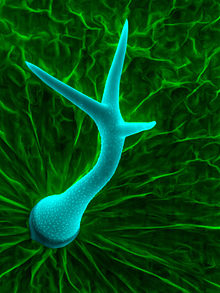
Other [edit]
Besides the camera, other methods of forming images with light are bachelor. For instance, a photocopy or xerography machine forms permanent images but uses the transfer of static electrical charges rather than photographic medium, hence the term electrophotography. Photograms are images produced by the shadows of objects cast on the photographic paper, without the use of a camera. Objects can also be placed directly on the drinking glass of an image scanner to produce digital pictures.
Types [edit]
Amateur [edit]
Amateur photographers take photos for personal utilize, equally a hobby or out of casual interest, rather than as a business or job. The quality amateur piece of work can be comparable to that of many professionals. Amateurs can fill a gap in subjects or topics that might non otherwise be photographed if they are non commercially useful or salable. Amateur photography grew during the tardily 19th century due to the popularization of the hand-held camera.[53] Twenty-first century social media and nigh-ubiquitous camera phones have made photographic and video recording pervasive in everyday life. In the mid-2010s smartphone cameras added numerous automatic assistance features like color management, autofocus face detection and epitome stabilization that significantly decreased skill and effort needed to take loftier quality images.[54]
Commercial [edit]
Commercial photography is probably all-time defined as any photography for which the photographer is paid for images rather than works of art. In this calorie-free, money could be paid for the subject of the photograph or the photograph itself. Wholesale, retail, and professional uses of photography would autumn nether this definition. The commercial photographic world could include:
- Advertizement photography: photographs made to illustrate and unremarkably sell a service or product. These images, such every bit packshots, are generally done with an advertizing bureau, blueprint firm or with an in-business firm corporate design team.
- Architectural photography focuses on capturing photographs of buildings and architectural structures that are aesthetically pleasing and accurate in terms of representations of their subjects.
- Event photography focuses on photographing guests and occurrences at mostly social events.
- Fashion and glamour photography normally incorporates models and is a course of advertizement photography. Fashion photography, like the piece of work featured in Harper's Bazaar, emphasizes clothes and other products; glamour emphasizes the model and body form. Glamour photography is popular in advertizement and men'south magazines. Models in glamour photography sometimes piece of work nude.
- 360 production photography displays a series of photos to give the impression of a rotating object. This technique is commonly used by ecommerce websites to assistance shoppers visualise products.
- Concert photography focuses on capturing candid images of both the artist or band as well as the temper (including the crowd). Many of these photographers work freelance and are contracted through an creative person or their management to comprehend a specific show. Concert photographs are often used to promote the artist or band in improver to the venue.
- Law-breaking scene photography consists of photographing scenes of law-breaking such as robberies and murders. A black and white camera or an infrared camera may be used to capture specific details.
- Still life photography normally depicts inanimate subject matter, typically commonplace objects which may be either natural or man-made. Still life is a broader category for food and some natural photography and tin exist used for advertising purposes.
- Existent Estate photography focuses on the production of photographs showcasing a property that is for sale, such photographs requires the use of wide-lens and extensive cognition in Loftier-dynamic-range imaging photography.

Instance of a studio-made nutrient photograph.
- Food photography tin exist used for editorial, packaging or advertising use. Food photography is similar to withal life photography but requires some special skills.
- Photojournalism tin can be considered a subset of editorial photography. Photographs made in this context are accepted as a documentation of a news story.
- Paparazzi is a grade of photojournalism in which the photographer captures candid images of athletes, celebrities, politicians, and other prominent people.
- Portrait and nuptials photography: photographs made and sold straight to the end user of the images.
- Landscape photography depicts locations.
- Wild animals photography demonstrates the life of wild animals.
Art [edit]
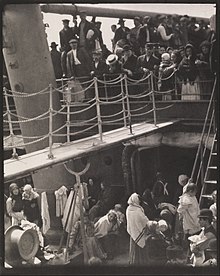
During the 20th century, both fine art photography and documentary photography became accepted past the English language-speaking art world and the gallery organisation. In the United States, a scattering of photographers, including Alfred Stieglitz, Edward Steichen, John Szarkowski, F. Holland Day, and Edward Weston, spent their lives advocating for photography as a fine art. At beginning, fine art photographers tried to imitate painting styles. This movement is called Pictorialism, oft using soft focus for a dreamy, 'romantic' look. In reaction to that, Weston, Ansel Adams, and others formed the Group f/64 to advocate 'straight photography', the photograph as a (sharply focused) affair in itself and not an imitation of something else.
The aesthetics of photography is a matter that continues to be discussed regularly, especially in artistic circles. Many artists argued that photography was the mechanical reproduction of an epitome. If photography is authentically art, then photography in the context of art would need redefinition, such every bit determining what component of a photograph makes it beautiful to the viewer. The controversy began with the earliest images "written with light"; Nicéphore Niépce, Louis Daguerre, and others among the very earliest photographers were met with acclaim, but some questioned if their work met the definitions and purposes of fine art.
Clive Bell in his archetype essay Art states that only "significant class" tin distinguish art from what is not fine art.
There must exist some ane quality without which a piece of work of art cannot be; possessing which, in the least caste, no work is altogether worthless. What is this quality? What quality is shared by all objects that provoke our aesthetic emotions? What quality is mutual to Sta. Sophia and the windows at Chartres, Mexican sculpture, a Persian bowl, Chinese carpets, Giotto's frescoes at Padua, and the masterpieces of Poussin, Piero della Francesca, and Cezanne? Only one answer seems possible – significant form. In each, lines and colors combined in a detail fashion, certain forms and relations of forms, stir our aesthetic emotions.[55]
On vii Feb 2007, Sotheby'southward London sold the 2001 photo 99 Cent Two Diptychon for an unprecedented $iii,346,456 to an anonymous bidder, making it the most expensive at the time.[56]
Conceptual photography turns a concept or thought into a photograph. Even though what is depicted in the photographs are real objects, the subject is strictly abstract.
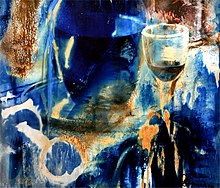
In parallel to this development, the and then largely separate interface between painting and photography was closed in the early 1970s with the work of the photo artists Pierre Cordier (Chimigramm), Chemigram and Josef H. Neumann, Chemogram. In 1974 the chemograms by Josef H. Neumann ended the separation of the painterly background and the photographic layer past showing the motion-picture show elements in a symbiosis that had never existed earlier, equally an unmistakable unique specimen, in a simultaneous painterly and at the same time real photographic perspective, using lenses, within a photographic layer, united in colors and shapes. This Neumann chemogram from the seventies of the 20th century thus differs from the beginning of the previously created cameraless chemigrams of a Pierre Cordier and the photogram Man Ray or László Moholy-Nagy of the previous decades. These works of art were almost simultaneous with the invention of photography by various important artists who characterized Hippolyte Bayard, Thomas Wedgwood, William Henry Fox Talbot in their early stages, and later Man Ray and László Moholy-Nagy in the twenties and by the painter in the thirties Edmund Kesting and Christian Schad past draping objects directly onto appropriately sensitized photo paper and using a calorie-free source without a photographic camera. [57]
Photojournalism [edit]

National Guardsman in Washington D.C. (2021)
Photojournalism is a particular class of photography (the collecting, editing, and presenting of news textile for publication or broadcast) that employs images in order to tell a news story. Information technology is now usually understood to refer merely to still images, but in some cases the term as well refers to video used in broadcast journalism. Photojournalism is distinguished from other shut branches of photography (e.chiliad., documentary photography, social documentary photography, street photography or celebrity photography) past complying with a rigid upstanding framework which demands that the work be both honest and impartial whilst telling the story in strictly journalistic terms. Photojournalists create pictures that contribute to the news media, and help communities connect with one other. Photojournalists must be well informed and knowledgeable almost events happening right outside their door. They deliver news in a artistic format that is non only informative, but also entertaining, including sports photography.
Science and forensics [edit]

The camera has a long and distinguished history as a means of recording scientific phenomena from the beginning utilise by Daguerre and Pull a fast one on-Talbot, such as astronomical events (eclipses for example), small-scale creatures and plants when the camera was attached to the eyepiece of microscopes (in photomicroscopy) and for macro photography of larger specimens. The camera too proved useful in recording offense scenes and the scenes of accidents, such as the Wootton bridge collapse in 1861. The methods used in analysing photographs for use in legal cases are collectively known as forensic photography. Criminal offence scene photos are taken from three vantage point. The vantage points are overview, mid-range, and shut-up.[58]
In 1845 Francis Ronalds, the Honorary Director of the Kew Observatory, invented the first successful camera to make continuous recordings of meteorological and geomagnetic parameters. Different machines produced 12- or 24- hour photographic traces of the minute-by-infinitesimal variations of atmospheric pressure, temperature, humidity, atmospheric electricity, and the three components of geomagnetic forces. The cameras were supplied to numerous observatories around the world and some remained in employ until well into the 20th century.[59] [60] Charles Brooke a footling later developed similar instruments for the Greenwich Observatory.[61]
Scientific discipline uses image applied science that has derived from the design of the Pin Hole camera. Ten-Ray machines are similar in design to Pivot Hole cameras with high-course filters and light amplification by stimulated emission of radiation radiation.[62] Photography has become universal in recording events and data in science and engineering, and at offense scenes or accident scenes. The method has been much extended by using other wavelengths, such as infrared photography and ultraviolet photography, every bit well as spectroscopy. Those methods were first used in the Victorian era and improved much further since that fourth dimension.[63]
The first photographed atom was discovered in 2012 by physicists at Griffith University, Australia. They used an electric field to trap an "Ion" of the element, Ytterbium. The epitome was recorded on a CCD, an electronic photographic film.[64]
Wildlife Photography [edit]
Wildlife photography involves capturing images of various forms of wildlife. Different other forms of photography such as product or food photography, successful wildlife photography requires a photographer to choose the correct identify and right time when specific wild animals are present and active. It often requires great patience and considerable skill and command of the right photographic equipment.[65]
Social and cultural implications [edit]
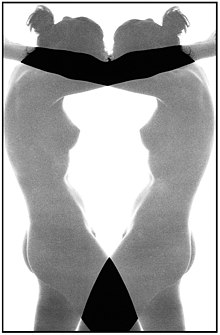

In that location are many ongoing questions about different aspects of photography. In her On Photography (1977), Susan Sontag dismisses the objectivity of photography. This is a highly debated subject within the photographic community.[66] Sontag argues, "To photograph is to appropriate the thing photographed. Information technology means putting one's cocky into a certain relation to the world that feels like knowledge, and therefore like power."[67] Photographers decide what to take a photo of, what elements to exclude and what bending to frame the photo, and these factors may reflect a particular socio-historical context. Along these lines, it can be argued that photography is a subjective form of representation.
Modern photography has raised a number of concerns on its effect on order. In Alfred Hitchcock's Rear Window (1954), the camera is presented as promoting voyeurism. 'Although the camera is an observation station, the deed of photographing is more than passive observing'.[67]
The camera doesn't rape or even possess, though information technology may assume, intrude, trespass, misconstrue, exploit, and, at the farthest reach of metaphor, assassinate – all activities that, unlike the sexual push and shove, can exist conducted from a altitude, and with some disengagement.[67]
Digital imaging has raised ethical concerns considering of the ease of manipulating digital photographs in post-processing. Many photojournalists have declared they volition non crop their pictures or are forbidden from combining elements of multiple photos to brand "photomontages", passing them as "real" photographs. Today'south applied science has made prototype editing relatively simple for even the novice photographer. Notwithstanding, recent changes of in-photographic camera processing allow digital fingerprinting of photos to detect tampering for purposes of forensic photography.
Photography is one of the new media forms that changes perception and changes the construction of society.[68] Farther unease has been caused around cameras in regards to desensitization. Fears that agonizing or explicit images are widely accessible to children and society at large have been raised. Particularly, photos of war and pornography are causing a stir. Sontag is concerned that "to photo is to plow people into objects that tin can be symbolically possessed". Desensitization discussion goes hand in manus with debates about censored images. Sontag writes of her business organisation that the power to conscience pictures ways the photographer has the ability to construct reality.[67]
1 of the practices through which photography constitutes society is tourism. Tourism and photography combine to create a "tourist gaze"[69] in which local inhabitants are positioned and defined by the camera lens. Nevertheless, it has also been argued that there exists a "opposite gaze"[70] through which indigenous photographees can position the tourist photographer equally a shallow consumer of images.
Law [edit]
Photography is both restricted and protected by the law in many jurisdictions. Protection of photographs is typically accomplished through the granting of copyright or moral rights to the photographer. In the Us, photography is protected as a First Amendment right and anyone is free to photograph anything seen in public spaces as long equally it is in plain view.[71] In the UK a recent police force (Counter-Terrorism Human activity 2008) increases the power of the law to prevent people, even press photographers, from taking pictures in public places.[72] In South Africa, any person may photograph whatever other person, without their permission, in public spaces and the only specific restriction placed on what may not be photographed past government is related to anything classed equally national security. Each country has different laws.
See also [edit]
- Outline of photography
- Science of photography
- List of photographers
- Listing of photography awards
- Astrophotography
- Paradigm editing
- Imaging
- Photolab and minilab
- Visual arts
- World Photography Day
References [edit]
- ^ Spencer, D A (1973). The Focal Dictionary of Photographic Technologies. Focal Printing. p. 454. ISBN978-0-xiii-322719-2.
- ^ φάος Archived 25 May 2013 at the Wayback Motorcar, Henry George Liddell, Robert Scott, A Greek-English Lexicon, on Perseus
- ^ γραφή Archived 25 May 2013 at the Wayback Automobile, Henry George Liddell, Robert Scott, A Greek-English Lexicon, on Perseus
- ^ Harper, Douglas. "photograph". Online Etymology Dictionary.
- ^ Boris Kossoy (2004). Hercule Florence: El descubrimiento de la fotografía en Brasil. Instituto Nacional de Antropología eastward Historia. ISBN978-968-03-0020-iv. Archived from the original on 28 April 2016. Retrieved xiii December 2015.
- ^ Boris Kossoy (1980). Hercule Florence: a descoberta isolada da fotografia no Brasil. São Paulo: Duas Cidades. ISBN9788531409448.
- ^ "Photophys.com: The Scientific discipline of Photography: Appreciation through Understanding". photophys.com. Archived from the original on eighteen January 2017. Retrieved 25 June 2019.
- ^ Mathur, P, K & S (half dozen March 2014). Developments and Changes in Science Based Technologies. Partridge Publishing. p. 50. ISBN9781482813982 . Retrieved 25 June 2019.
- ^ a b Eder, J.1000. (1945) [1932]. History of Photography, quaternary. edition [Geschichte der Photographie]. New York: Dover Publications, Inc. pp. 258–59. ISBN978-0-486-23586-8.
- ^ "Sir John Frederick William Herschel (British, 1792–1871) (Getty Museum)". The J. Paul Getty in Los Angeles. Archived from the original on one October 2018. Retrieved xx June 2019.
- ^ Campbell, January (2005) Moving picture and cinema spectatorship: melodrama and mimesis Archived 29 April 2016 at the Wayback Motorcar. Polity. p. 114. ISBN 0-7456-2930-X
- ^ a b Krebs, Robert E. (2004). Groundbreaking Scientific Experiments, Inventions, and Discoveries of the Middle Ages and the Renaissance. Greenwood Publishing Group. p. 20. ISBN978-0-313-32433-8.
- ^ Crombie, Alistair Cameron (1990) Scientific discipline, eyes, and music in medieval and early mod idea. A&C Black. p. 205. ISBN 978-0-907628-79-8
- ^ Wade, Nicholas J.; Finger, Stanley (2001). "The eye as an optical instrument: from camera obscura to Helmholtz's perspective". Perception. xxx (x): 1157–77. doi:10.1068/p3210. PMID 11721819. S2CID 8185797.
- ^ a b Plott, John C. (1984). Global History of Philosophy: The Period of scholasticism (office one). p. 460. ISBN978-0-89581-678-8.
According to Nazir Ahmed if only Ibn-Haitham's young man-workers and students had been as warning equally he, they might even have invented the art of photography since al-Haitham'southward experiments with convex and concave mirrors and his invention of the "pinhole camera" whereby the inverted epitome of a candle-flame is projected were among his many successes in experimentation. One might likewise almost claim that he had anticipated much that the nineteenth century Fechner did in experimentation with later-images.
- ^ a b Belbachir, Ahmed Nabil (2009). Smart Cameras. Springer Science & Business Media. ISBN978-one-4419-0953-4.
The invention of the camera can be traced back to the 10th century when the Arab scientist Al-Hasan Ibn al-Haytham allonym Alhacen provided the first articulate description and right analysis of the (human) vision process. Although the effects of unmarried light passing through the pinhole have already been described by the Chinese Mozi (Lat. Micius) (5th century B), the Greek Aristotle (fourth century BC), and the Arab
- ^ Wade, Nicholas J.; Finger, Stanley (2001), "The middle as an optical instrument: from camera obscura to Helmholtz's perspective", Perception, thirty (ten): 1157–1177, doi:10.1068/p3210, PMID 11721819, S2CID 8185797,
The principles of the camera obscura outset began to be correctly analysed in the eleventh century, when they were outlined by Ibn al-Haytham.
- ^ Needham, Joseph. Science and Civilization in China, vol. Four, function ane: Physics and Concrete Applied science (PDF). p. 98. Archived from the original (PDF) on 3 July 2017. Retrieved 5 September 2016.
Alhazen used the camera obscura particularly for observing solar eclipses, every bit indeed Aristotle is said to have done, and it seems that, similar Shen Kua, he had predecessors in its study, since he did not claim it every bit any new finding of his own. But his treatment of it was competently geometrical and quantitative for the first time.
- ^ "Who Invented Camera Obscura?". Photography History Facts.
All these scientists experimented with a pocket-sized hole and calorie-free only none of them suggested that a screen is used so an prototype from 1 side of a pigsty in surface could be projected at the screen on the other. First 1 to do so was Alhazen (also known equally Ibn al-Haytham) in 11th century.
- ^ Needham, Joseph. Science and Civilisation in People's republic of china, vol. Iv, function ane: Physics and Physical Applied science (PDF). p. 99. Archived from the original (PDF) on 3 July 2017. Retrieved 5 September 2016.
The genius of Shen Kua's insight into the relation of focal point and pinhole can meliorate exist appreciated when nosotros read in Vocaliser that this was offset understood in Europe by Leonardo da Vinci (+ 1452 to + 1519), almost five hundred years later. A diagram showing the relation occurs in the Codice Atlantico, Leonardo idea that the lens of the center reversed the pinhole event, so that the image did not appear inverted on the retina; though in fact it does. Actually, the analogy of focal-betoken and pin-point must have been understood past Ibn al-Haitham, who died just most the fourth dimension when Shen Kua was born.
- ^ Davidson, Michael Westward (13 November 2015). "Albertus Magnus". Molecular Expressions: Science, Optics and You. National High Magnetic Field Laboratory at The Florida State Academy. Archived from the original on 22 December 2015.
- ^ Potonniée, Georges (1973). The history of the discovery of photography. Arno Printing. p. fifty. ISBN 0-405-04929-3
- ^ Allen, Nicholas P.L. (1994). "A reappraisal of tardily thirteenth-century responses to the Shroud of Lirey-Chambéry-Turin: encolpia of the Eucharist, vera eikon or supreme relic?". The Southern African Periodical of Medieval and Renaissance Studies. 4 (1): 62–94.
- ^ Allen, Nicholas P.L. "Verification of the Nature and Causes of the Photo-negative Images on the Shroud of Lirey-Chambéry-Turin". unisa.ac.za
- ^ a b Gernsheim, Helmut (1986). A concise history of photography Archived 29 April 2016 at the Wayback Machine. Courier Dover Publications. pp. 3–iv. ISBN 0-486-25128-4
- ^ Gernsheim, Helmut and Gernsheim, Alison (1955) The history of photography from the earliest utilize of the photographic camera obscura in the eleventh century upwards to 1914. Oxford University Press. p. xx.
- ^ Litchfield, R. 1903. "Tom Wedgwood, the First Photographer: An Account of His Life." London, Duckworth and Co. See Chapter XIII. Includes the complete text of Humphry Davy's 1802 paper, which is the only known gimmicky record of Wedgwood's experiments. (Retrieved 7 May 2013 via archive.org Archived vii October 2015 at the Wayback Machine).
- ^ a b "The Get-go Photograph – Heliography". Archived from the original on 6 October 2009. Retrieved 29 September 2009.
from Helmut Gernsheim'south article, "The 150th Ceremony of Photography," in History of Photography, Vol. I, No. 1, January 1977: ...In 1822, Niépce coated a glass plate... The sunlight passing through... This offset permanent instance... was destroyed... some years later.
- ^ Hirsch, Robert (1999). Seizing the light: a history of photography. McGraw-Loma. ISBN978-0-697-14361-7. Archived from the original on 29 April 2016. Retrieved 13 Dec 2015.
- ^ William Henry Fox Talbot (1800–1877) Archived 3 October 2010 at the Wayback Machine. BBC
- ^ Feldman, Anthony and Ford, Peter (1989) Scientists & inventors. Bloomsbury Books, p. 128, ISBN 1-870630-23-8.
- ^ Trick Talbot, William Henry and Jammes, André (1973) William H. Fox Talbot, inventor of the negative-positive process, Macmillan, p. 95.
- ^ "Hippolyte Bayard (French, 1801–1887) (Getty Museum)". Archived from the original on 24 October 2013. Retrieved 21 April 2019.
- ^ Paulson Gage, Joan (5 Baronial 2013). "Icons of Cruelty". The New York Times.
- ^ History of Kodak, Milestones-chronology: 1878–1929 Archived ten Feb 2012 at the Wayback Automobile. kodak.com
- ^ Peres, Michael R. (2008). The Concise Focal Encyclopedia of Photography: from the showtime photo on newspaper to the digital revolution. Burlington, MA: Focal Press/Elsevier. p. 75. ISBN978-0-240-80998-4.
- ^ "H&D curve of movie vs digital" (Forum Discussion). Digital Photography Review. xix April 2004. Archived from the original on 23 September 2015.
- ^ Jacobson, Ralph E. (2000). The Focal Transmission of Photography: photographic and digital imaging (9th ed.). Boston, MA: Focal Press. ISBN978-0-240-51574-eight.
- ^ "Black & White Photography". PSA Journal. 77 (12): 38–forty. 2011.
- ^ a b "1861: James Clerk Maxwell's greatest year". King's Higher London. iii January 2017. Archived from the original on 4 January 2017. Retrieved three January 2017.
- ^ a b "From Charles Mackintosh's waterproof to Dolly the sheep: 43 innovations Scotland has given the world". The contained. 2 Jan 2016. Archived from the original on ii Oct 2017. Retrieved 2 Dec 2017.
- ^ "Research & Development". fujifilm.com . Retrieved 13 January 2022.
{{cite web}}: CS1 maint: url-condition (link) - ^ Schewe, Jeff (2012). The Digital Negative: Raw Prototype Processing In Lightroom, Photographic camera Raw, and Photoshop. Berkeley, CA: Peachpit Press, ISBN 0-321-83957-9, p. 72
- ^ "Glossary: Digital Photography Review". Dpreview.com. Archived from the original on eighteen January 2013. Retrieved 24 June 2013.
- ^ Anderson, Joseph; Anderson, Barbara (Spring 1993). "The Myth of Persistence of Vision Revisited". Journal of Film and Video. 45 (ane): 3–12. Archived from the original on 24 November 2009.
- ^ Belisle, Brooke (2013). "The Dimensional Image: Overlaps In Stereoscopic, Cinematic, And Digital Depth". Film Criticism. 37/38 (3/1): 117–37.
- ^ Zand, Tristan (8 April 2017). "An introduction to Dualphotography". Dual.Photo. Medium.com. Archived from the original on 16 April 2017. Retrieved 15 Apr 2017.
- ^ Twede, David. Introduction to Total-Spectrum and Infrared photography. surrealcolor.110mb.com
- ^ Lackey, Tamara (12 May 2016). "Incorporating Layering Composition Into Your Photography". 42 W. Archived from the original on 14 September 2021. Retrieved 14 September 2021.
- ^ Goldby, Dylan (20 January 2019). "Using layers to enhance your photography". Fujilove Magazine . Retrieved xiv September 2021.
- ^ "How to employ layering in photography for exceptional photos". Parker Photographic. i Dec 2020. Retrieved 14 September 2021.
- ^ Ng, Ren (July 2006) Digital Calorie-free Field Photography. PhD Thesis, Stanford Academy
- ^ Peterson, C.A. (2011). "Abode Portraiture". History of Photography. 35 (iv): 374–87. doi:ten.1080/03087298.2011.606727. S2CID 216590139.
- ^ Oloruntimilehin, Israel (17 September 2018). "How To Take Good Pictures With Your Phone". List Dorm. Archived from the original on 16 October 2018.
- ^ Clive Bong. "Art Archived 3 August 2004 at the Wayback Machine", 1914. Retrieved ii September 2006.
- ^ Schonauer, David (7 March 2007). "The first $3M photograph". PopPhoto. Archived from the original on 18 March 2007.
- ^ Hannes Schmidt: Comments on the chemograms by Josef H. Neumann. Exhibition in the "Fotografik Studio Galerie von Prof. Pan Walther". in: Photograph-Presse. Heft 22, 1976, S. 6.
- ^ Rohde, R.R. (2000). Crime Photography. PSA Journal, 66(3), 15.
- ^ Ronalds, B.F. (2016). Sir Francis Ronalds: Father of the Electric Telegraph. London: Purple College Press. ISBN978-1-78326-917-four.
- ^ Ronalds, B.F. (2016). "The Beginnings of Continuous Scientific Recording using Photography: Sir Francis Ronalds' Contribution". European Order for the History of Photography. Archived from the original on xiii June 2016. Retrieved 2 June 2016.
- ^ Brooke (1853). "Photographic self-registering magnetic and meteorological apparatus: Invented by Mr. Brooke of Keppel-Street, London". The Illustrated Magazine of Art. one (5): 308–eleven. doi:10.2307/20537989. JSTOR 20537989. Archived from the original on 29 Apr 2016. Retrieved 13 Dec 2015.
- ^ Upadhyay, J.; Chakera, J.A.; Navathe, C.P.; Naik, P.A.; Joshi, A.S.; Gupta, P.D. (2006). "Development of single frame X-ray framing camera for pulsed plasma experiments". Sādhanā. 31 (5): 613. CiteSeerXx.1.1.570.172. doi:10.1007/BF02715917. S2CID 123558773.
- ^ Blitzer, Herbert Fifty.; Stein-Ferguson, Karen; Huang, Jeffrey (2008). Agreement forensic digital imaging. Academic Press. pp. viii–ix. ISBN978-0-12-370451-i. Archived from the original on 29 April 2016. Retrieved 13 December 2015.
- ^ Glenday, Craig (2013). Guinness World Records 2014. p. 192. ISBN978-1-908843-15-9.
- ^ "Wild animals photography". BBC . Retrieved fourteen June 2020.
- ^ Bissell, K.Fifty. (2000). "A Return to 'Mr. Gates': Photography and Objectivity". Paper Enquiry Periodical. 21 (3): 81–93. doi:ten.1177/073953290002100307. S2CID 140920402.
- ^ a b c d Sontag, S. (1977) On Photography, Penguin, London, pp. three–24, ISBN 0-312-42009-9.
- ^ Levinson, P. (1997) The Soft Edge: a Natural History and Future of the Information Revolution, Routledge, London and New York, pp. 37–48, ISBN 0-415-15785-4.
- ^ Urry, John (2002). The tourist gaze (2nd ed.). London: Sage. ISBN978-0-7619-7347-8.
- ^ Gillespie, Alex. "Tourist Photography and the Reverse Gaze".
- ^ "You Accept Every Correct to Photo That Cop". American Civil Liberties Union. Archived from the original on 25 February 2016. Retrieved eighteen February 2016.
- ^ "Jail for photographing constabulary?". British Periodical of Photography. 28 January 2009. Archived from the original on 27 March 2010.
Further reading [edit]
Introduction [edit]
- Barrett, T 2012, Criticizing Photographs: an introduction to understanding images, 5th edn, McGraw-Hill, New York.
- Bate, D. (2009), Photography: The Key Concepts, Bloomsbury, New York.
- Berger, J. (Dyer, M. ed.), (2013), Understanding a Photograph, Penguin Classics, London.
- Bright, S 2011, Fine art Photography At present, Thames & Hudson, London.
- Cotton, C. (2015), The Photograph as Contemporary Art, 3rd edn, Thames & Hudson, New York.
- Heiferman, Thou. (2013), Photography Changes Everything, Aperture Foundation, United states.
- Shore, S. (2015), The Nature of Photographs, 2d ed. Phaidon, New York.
- Wells, L. (2004), Photography. A Critical Introduction [Paperback], 3rd ed. Routledge, London. ISBN 0-415-30704-10
History [edit]
- A New History of Photography, ed. past Michel Frizot, Köln : Könemann, 1998
- Franz-Xaver Schlegel, Das Leben der toten Dinge – Studien zur modernen Sachfotografie in den USA 1914–1935, 2 Bände, Stuttgart/Federal republic of germany: Fine art in Life 1999, ISBN 3-00-004407-8.
Reference works [edit]
- Tom Ang (2002). Dictionary of Photography and Digital Imaging: The Essential Reference for the Modern Photographer. Watson-Guptill. ISBN978-0-8174-3789-three.
- Hans-Michael Koetzle: Das Lexikon der Fotografen: 1900 bis heute, Munich: Knaur 2002, 512 p., ISBN 3-426-66479-8
- John Hannavy (ed.): Encyclopedia of Nineteenth-Century Photography, 1736 p., New York: Routledge 2005 ISBN 978-0-415-97235-ii
- Lynne Warren (Hrsg.): Encyclopedia of Twentieth-Century Photography, 1719 p., New York: Routledge, 2006
- The Oxford Companion to the Photograph, ed. past Robin Lenman, Oxford University Press 2005
- "The Focal Encyclopedia of Photography", Richard Zakia, Leslie Stroebel, Focal Printing 1993, ISBN 0-240-51417-3
- Stroebel, Leslie (2000). Bones Photographic Materials and Processes. et al. Boston: Focal Press. ISBN978-0-240-80405-7.
Other books [edit]
- Photography and The Art of Seeing by Freeman Patterson, Key Porter Books 1989, ISBN 1-55013-099-4.
- The Art of Photography: An Arroyo to Personal Expression by Bruce Barnbaum, Rocky Nook 2010, ISBN 1-933952-68-7.
- Image Clarity: Loftier Resolution Photography by John B. Williams, Focal Press 1990, ISBN 0-240-80033-viii.
External links [edit]
- World History of Photography From The History of Fine art.
- Daguerreotype to Digital: A Brief History of the Photographic Procedure From the Country Library & Athenaeum of Florida.
Source: https://en.wikipedia.org/wiki/Photography
Posted by: conleywaseve1964.blogspot.com

0 Response to "Can You Have Camera Photo Hobby Air Force"
Post a Comment